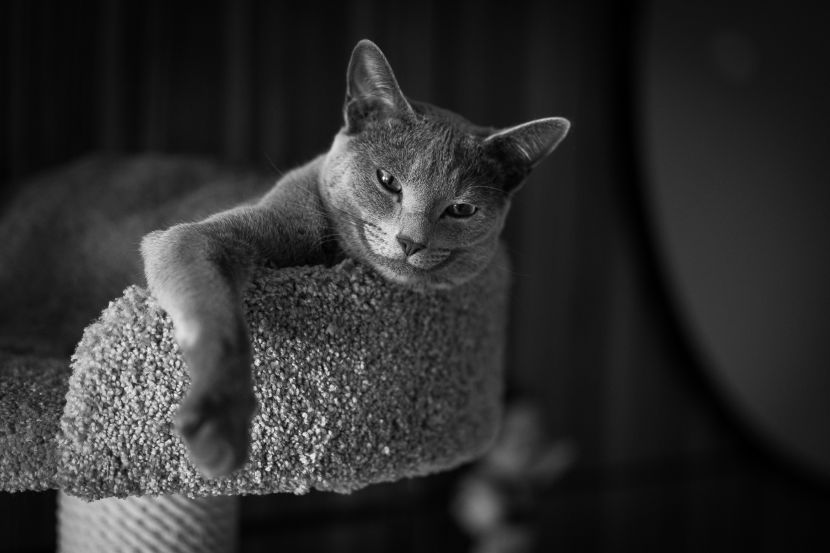
The ancestors of this bluish-silver beauty with a graceful gait lived in the west of Russia, and her striking features are longevity and an eternal smile on her lips.
The origin of the Russian blue cat is not fully known, but it is believed to originate from western Russia, specifically the Arkhangelsk region.
Since the port of the same name on the Barents Sea was a meeting place for sailors from all over the world, many sailors and travelers caught the eye of a beautiful cat with shiny gray-blue fur and a supple body. Her coat was waterproof, which is why she was unfortunately often hunted.
Preservation of the race
After the end of the Second World War, only a few specimens of these cats remained. English and Scandinavian breeders tried to restore the breed by crossing it with the blue color-point Siamese cat. However, interbreeding spoiled the appearance of the breed, so the quality of the fur was lost, and the cats were smaller, more delicately built, with a narrow body and a flat profile. Fortunately, breeders appeared who, in the early 60s of the last century, tried to restore the characteristic features of the Archangel cat. The Eastern or Siamese type has become undesirable. Thanks to careful selection, ten years later, the Russian blue cat appears in the former edition, with a wedge-shaped head, flat panels and a bulging corner at the "intersection" of the forehead and nose. The fur was again as before, distinctly short, silky and thick, with silvery tips and an undercoat of the same length.
Three types of Russian blue cats
Three types of Russian blue cats are seen today: American, English and Scandinavian. The American type differs the most from the original Archangel cat, specimens are more delicately built but very temperamental, with lighter hair, distinctly spaced ears and bright green eyes. English-type Russian cats are stronger, have a calmer temperament, have high-set ears, a pronounced muzzle and chin, and very thick hair. The Scandinavian type of breed, also known as European, includes cats with a more elegant build, with expressive and spaced ears.
The Russian Blue cat has prominent cheeks, so it always seems to be smiling. The eyes of an adult cat are a striking emerald green, while kittens can have blue, orange or green eyes. The body of the Russian Blue cat is strong and toned, elegant and harmonious. In addition to blue-silver fur, Russian blue cats are sometimes "covered" with white and black fur. Their weight is between three and six kilograms.

Traits and temperament of the breed
The Russian Blue cat is very calm and quiet, sometimes it even seems unable to meow. She is gentle and very attached to her owner, whom she follows closely. Although she is constantly with her owner, she is also very independent, so she can stay alone in the home without any problems. They will never do any harm. She likes the company of children and other animals, is cuddly and doesn't scratch. She is extremely intelligent, a quick learner and loves toss-and-go games. If you choose this breed, you can be sure that you will have a smart cat next to you who quickly learns to behave and can master many games and tricks. She is shy and reserved towards strangers, but she will never attack them.
Russian Blue Cat Care
This cat does not need much grooming. She does most of the work herself, but you can brush her once a week. Some owners advise not to expose her to too much sunlight, as it will supposedly change her fur color. This kitty hardly sheds, so you don't have to worry too much about hair on the furniture. It is very neat and clean and has no smell. While she is small, she gets used to being sprinkled very quickly and never defecates in unauthorized places in the home.
The Russian blue cat lives about 15 years, but if it has good conditions, its lifespan can be even longer. This breed is known to be healthy and resistant to many diseases. Since it does not shed, it is ideal for people with allergies.
Diet of the Russian Blue Cat
A Russian Blue cat should eat a high-quality food rich in protein. Do not feed her leftovers from your table, as she will gain weight and become susceptible to health problems. If you give her granules or canned food, mix it with a little water: cats don't take in enough liquid, so this way you will make her drink more water. Fresh water should always be available to them. As the cat ages, adjust her diet: offer the old lady food with less fat and light meals that are nutritionally adapted to her needs and age.


